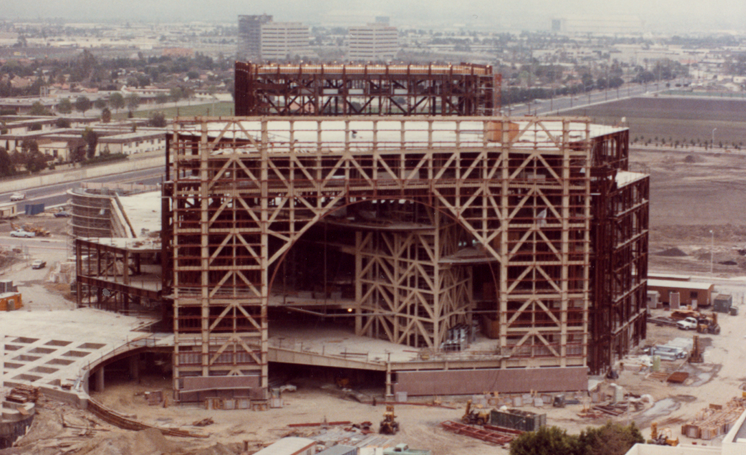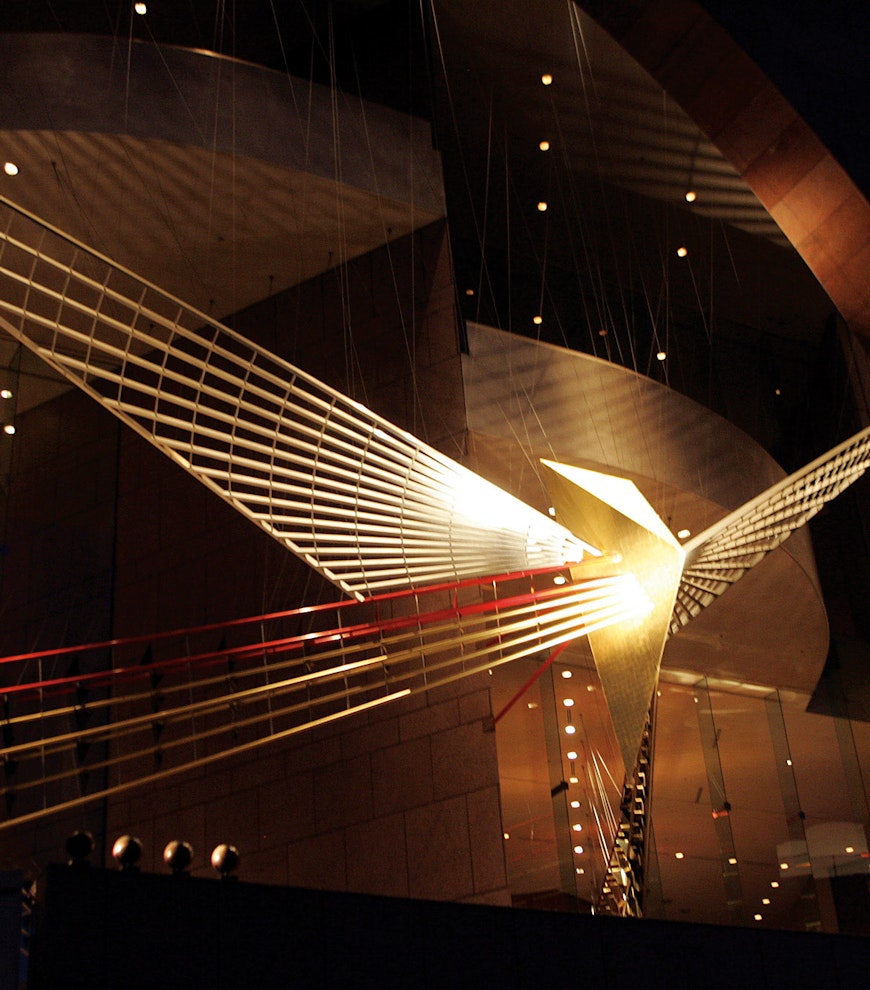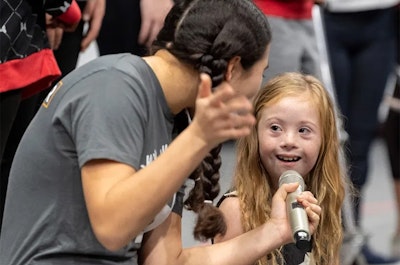Early days
In the late 1960s, a number of Orange County community leaders decided it was time to have world-class performing arts venues and a dedicated arts campus where local and regional performing arts organizations and esteemed guest artists and companies from all over the world could perform for this rapidly growing and culturally diverse region of Southern California. Businesses were headquartering here and major educational institutions were being established. Pacific Symphony, the Philharmonic Society of Orange County, and Pacific Chorale needed a concert hall with seating and acoustics appropriate to their needs and the caliber of their performances. It should be a setting where those organizations, the new Orange County Performing Arts Center, and the community could grow and achieve greater prestige and recognition.
By the mid-‘70s, the Center had its site: a five-acre parcel of land donated by the local Segerstrom family along with lead financial gifts. Construction began in 1983.
The vision of the Center's founders became reality when the Orange County Performing Arts Center opened on September 29, 1986 with a concert in its new opera house-style Segerstrom Hall. It was one of the nation’s most innovative and technically advanced homes for the performing arts. To the performances by Pacific Symphony, the Philharmonic Society, and Pacific Chorale, the Center’s leadership added celebrated international ballet companies, national tours of Broadway musicals, jazz greats, award-winning chamber ensembles, cabaret artists and children’s theater. The Center also established an ambitious education department dedicated to bringing young people to the new campus for live, professional performances and to providing meaningful arts programs to schools throughout the county.
Expansion
The new Renée and Henry Segerstrom Concert Hall opened on September 15, 2006, named for the Center’s founding chairman and his late wife. Samueli Theater, the intimate 500-seat multi-use venue included in the concert hall complex, was named for the Henry Samueli Family Foundation. And Leatherby’s Café Rouge, named for long-time Orange County philanthropist George Leatherby, added a taste of the culinary arts to the Center’s campus.
Our Next Act
In 2015, the Center announced The Next Act: three bold initiatives that would advance the goal of becoming a more vital force throughout the community while maintaining its recognized commitment to artistic excellence.
- Center for Dance and Innovation supports Segerstrom Center’s flagship artistic programs, while acting as a catalyst for initiatives that celebrate innovation and creativity. Under the auspices of the CDI, the Center established the American Ballet Theatre William J. Gillespie School and Studio D: Arts School for All Abilities. Programs also support the commissioning of new ballets, dance training in multiple genres, Center partnerships with the high-tech, bio-tech/entrepreneur community and others, offering new ways of engaging with the performing arts through a broad array of on-site, off-campus and online programs.
- In the fall of 2015, the Center expanded its then 27-year relationship with American Ballet Theatre by establishing the American Ballet Theatre William J. Gillespie School at Segerstrom Center for the Arts. The school bears the name of William J. Gillespie, an enthusiastic and generous donor to the Center for many years and a member of the ABT board of directors. This historic partnership looks to the future to offer unrivaled opportunities for training, nurturing future generations of dancers and dance audiences as well as furthering the development and evolution of dance.
- The Center opened its school of dance and music for children with disabilities in 2016, now called Studio D: Arts School for All Abilities. The school welcomes students ages 4–22. Classes are inclusive, but specially designed for those with physical and cognitive disabilities such as Down syndrome, cerebral palsy, autism spectrum disorders, hearing and visual impairments and other complex needs, as well as siblings and children without disabilities. The classes help the students to explore their full physical, creative, and social potential through dance, creative movement, music and sensory tools.
- Center Without Boundaries is a program that emphasizes civic engagement and focuses on responding to needs of individual and diverse communities by forging strategic partnerships between the Center and non-cultural groups throughout the county. Among those partnerships include associations with Alzheimer’s Orange County, Camp Pendleton, CHOC Children’s Hospital, El Central Cultural de Mexico, Very Special Arts Orange County, Chapman University, University of California Irvine, Orange County Asian and Pacific Islanders Community Alliance, UCP Orange County and many others.
- Julianne and George Argyros Plaza, completed in 2017, was designed by the renowned firm of Michael Maltzan Architecture. The existing Arts Plaza was reimagined into a welcoming public gathering place. The Argyros Plaza is enhanced with a large stage, shade trees, picnic and dining areas, free WIFI and an outdoor restaurant, George’s Café. The plaza is dedicated to the community and offers year-round free performances, festivals and community events.

Construction Began on the Orange County Performing Arts Center

Renée and Henry Segerstrom Concert Hall opens
.jpg?format=auto&fit=crop&w=870&h=990&crop=focalpoint&fp-y=.7&auto=format)
Richard Serra's "Connector"
Richard Serra’s towering sculpture, "Connector," commissioned by Elizabeth and Henry Segerstrom for the new plaza, was added to the Center’s public art collection that already included Richard Lippold’s "Fire Bird," a gift of the Segerstrom family, and Henry Moore’s "Reclining Figure," provided by the Center’s Angels of the Arts women’s support group. "Fire Bird," appearing to soar through the Segerstrom Hall Grand Portal has become the Center’s signature icon and a local landmark.
.jpg?format=auto&fit=crop&w=870&h=990&crop=focalpoint&auto=format)
Henry Moore’s "Reclining Figure"
An iconic example of the British sculptor’s mature work and a 1984 gift from the Angels of the Arts, a major supporter of Segerstrom Center for the Arts. "Reclining Figure", like the majority of Moore’s public works in cities around the world, is based on the human figure – usually standing, sitting, or most often, reclining on a plinth.
Vital and mysterious, like the spirit embodied in Stonehenge, Moore’s reclining female forms are universal shapes to which everyone is subconsciously conditioned to respond; simple, massive, deeply human figures are clearly represented in his "Reclining Figure". This sculpture is at the end of Town Center Drive on Segerstrom Center's Orchestra Level Terrace.

Richard Lippold's "Fire Bird"
Commissioned by Henry Segerstrom for the new Orange County Performing Arts Center that he generously donated to the city of Costa Mesa. Fire Bird is a major architectural sculpture of enormous scale created by Richard Lippold.
The gold, red, and silver colored stainless steel and aluminum sculpture was named Fire Bird by the late Renée Segerstrom as an homage to Igor Stravinsky’s ballet of the same title. Lippold conceived of his sculptures as objects in space, which he developed from a Constructivist model. He was devoted to pure geometry, seeing it as a metaphor for the universe and its philosophical mystique. With very few exceptions, Lippold’s constructions in space employ simple geometric forms that outline triangles, cubes, pyramids, cones, and circles. The viewer need not analyze Lippold’s geometric webs of stretched wire to appreciate the beauty, elegance, and the tension Fire Bird creates in equilibrium with the architecture of Segerstrom Hall.

American Ballet Theatre William J. Gillespie School at Segerstrom Center for the Arts established

Studio D: Arts School for All Abilities opens

Julianne and George Argyros Plaza completed
Today, Segerstrom Center for the Arts is one of the nation’s most respected multi-disciplinary cultural institutions. It is Orange County’s largest non-profit arts organization. The Center remains committed to supporting artistic excellence, offering unsurpassed experiences and to engaging the entire community in new and exciting ways through the unique power of live performance and a diverse array of inspiring arts-based education and community engagement programs.
.jpg?format=auto&fit=crop&fp-y=.8&w=1600&h=600&auto=format)
.jpg?format=auto&fit=crop&w=1760&h=670&auto=format)
.jpg?format=auto&fit=crop&w=720&h=530&auto=format)

























































